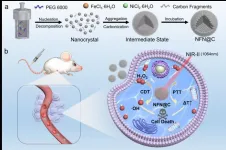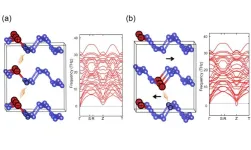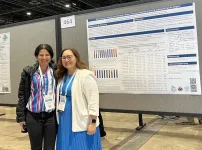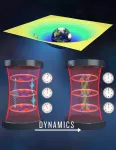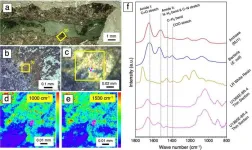(Press-News.org) A type of Artificial Intelligence that mimics the functioning of the human brain could represent a powerful solution in automatically detecting wildfires, plummeting the time needed to mitigate their devastating effects, a new study finds.
The new technology uses an ‘Artificial Neural Networks’ model that combines satellite imaging technology with deep learning (a subset of Artificial Intelligence (AI) and machine learning).
Findings, published in the peer-reviewed International Journal of Remote Sensing, report a 93% success rate when training the model via a dataset of images of Amazon rainforest with, and without, wildfires.
The technology, it is stated, could be used in a complementary nature with existing AI systems to enhance early warning systems and improve wildfire response strategies.
“The ability to detect and respond to wildfires is crucial for preserving the delicate ecological balance of these vital ecosystems, and the future of this Amazon region depends on decisive rapid action,” explains lead author Professor Cíntia Eleutério of the Universidade Federal do Amazonas, in Manaus.
“Our study’s findings could improve wildfire detection in the Amazonian ecosystem and elsewhere in the world, significantly assisting authorities in combating and managing such incidents.”
In 2023 there were 98,639 wildfires in the Amazon alone. The Amazon rainforest, too, accounts for a significant portion (51.94%) of wildfires in the Brazilian biomes. In recent years this area has experienced a notable increase in such incidents.
Currently, monitoring in the Amazon is provided with near, real-time data – however, it has moderate resolutions and the ability to detect details in remote areas or smaller fire outbreaks is limited.
This new technology uses a type of artificial neural network (a machine learning algorithm that uses a network of interconnected nodes to process data in a way that mimics the human brain) called a Convolutional Neural Network (CNN) to classify areas of the rainforest affected by wildfires and improve the issue. The algorithms developed enhance their performance over time through exposure to increasing volumes of data.
The research team, who are all based at the Universidade Federal do Amazonas, used images sourced from the Landsat 8 and 9 satellites to train the CNN. These satellites are fitted with near-infrared and shortwave infrared, which together are critical for detecting vegetation changes, as well as surface temperature alterations.
First, the CNN was trained on a dataset of 200 images of wildfires and an equal number of images without wildfires to ensure a balanced learning approach. Although small, this number of images proved sufficient for the CNN to achieve 93% accuracy during the training phase.
The CNN’s ability to distinguish between images with and without wildfires was then tested using 40 images not included in the training dataset. The model correctly classified 23 of the 24 images with wildfires and all 16 of the images without wildfires, thus underscoring its robustness and capability for generalisation, and showcasing its potential as a tool for effective wildfire detection.
“The CNN model could serve as a valuable addition, enabling more detailed analyses in specific regions. By combining the wide temporal coverage of the current sensors with the spatial precision of our model, we can significantly enhance wildfire monitoring in critical environmental preservation zones,” states co-author Professor Carlos Mendes, who has a PhD in physics.
“The model has the potential to significantly assist competent authorities in combating and managing such incidents, providing an advanced and more localized approach to wildfire detection.
“It serves as a complement to well-established large-scale monitoring systems, such as the satellite-based Moderate Resolution Imaging Spectroradiometer (MODIS) and Visible Infrared Imaging Radiometer Suite (VIIRS) which are widely used for continuous wildfire detection.”
Going forward, the authors recommend increasing the number of training images for CNN to work on, which “will undoubtedly lead to a more robust model”.
Other applications, they suggest, for the CNN could also be explored – such as monitoring and controlling deforestation.
END
AI has ‘great potential’ for detecting wildfires, new study of the Amazon rainforest suggests
Integrating this new technology with current AI systems could help detect wildfires, such as the devastating LA blazes, to enhance earlier warning strategies – experts believe
2025-03-06
ELSE PRESS RELEASES FROM THIS DATE:
Magnetic catalysts enhance tumor treatment via electronic density regulation
2025-03-06
Recently, a collaborative research team led by Professor WANG Hui and Professor ZHANG Xin from the Hefei Institutes of Physical Science of the Chinese Academy of Sciences, successfully developed a novel carbon-coated nickel ferrite (NFN@C) nanocatalyst with significant potential in cancer therapy.
The results have been published in Advanced Functional Materials.
Cancer therapy has always struggled with targeting tumor cells effectively while minimizing damage to healthy tissue. Traditional treatments like chemotherapy and radiation often have limited precision and serious side effects. This has led to increased ...
Quantum dot discovery for LEDs brings brighter, more eco-friendly displays
2025-03-06
New research by Curtin University has achieved a breakthrough in eco-friendly display technology, creating highly efficient and stable blue quantum dot LEDs (QLEDs) that could power the next generation of televisions, smartphones, VR headsets and energy-efficient lighting - without using toxic heavy metals.
Study author Associate Professor Guohua Jia from Curtin’s School of Molecular and Life Sciences said QLEDs are a futuristic display technology known for their superior brightness, colour accuracy, lifetime and energy efficiency compared to traditional LEDs. However, creating stable and efficient blue QLEDs without toxic materials ...
Phosphorus doping stabilizes high-energy polymeric nitrogen at ambient pressure
2025-03-06
Using first-principles calculations, a research group led by Prof. WANG Xianlong from the Hefei Institutes of Physical Science of the Chinese Academy of Sciences, found that phosphorus doping is an effective way to achieve high-energy polymeric nitrogen with black-phosphorus structure (BP-N) stable at ambient pressure.
The research results were published in Matter and Radiation at Extremes.
Cubic gauche nitrogen with diamond-like structure and BP-N with black phosphorus structure, represented by polymeric all-nitrogen materials, are a class of high-energy density materials composed entirely of N-N single bonds, but their samples ...
Maternal cannabis use triples risk of disruptive behaviour in children
2025-03-06
Children exposed to their mother’s cannabis use during pregnancy and after birth are three times more likely to develop behavioural problems, new Curtin University research has found.
Published in Psychiatry Research, the study analysed data from more than 222,600 Australian mothers and children, revealing maternal cannabis use disorder (CUD) during pregnancy and the postnatal period significantly increased the risk of childhood disruptive behavioural disorders.
Lead researcher Abay Tadesse, from Curtin’s School of Population ...
Balancing Nutrition: Micronutrient study could help prevent childhood obesity in Pacific region
2025-03-06
Children ages two to eight years across 11 Pacific jurisdictions (Alaska, American Samoa, Commonwealth of the Northern Mariana Islands, Federated States of Micronesia, Guam, Hawai‘i, Marshall Islands, and Palau) are not meeting daily recommended intakes for key micronutrients, either consuming too much or too little. That discovery was published recently in a study led by scientists at the University of Hawai‘i (UH) at Mānoa. The research team also found associations between children’s micronutrient intake, obesity, and presence of acanthosis nigricans, a skin condition that is ...
Lightening the load of augmented reality glasses
2025-03-06
An international team of scientists developed augmented reality glasses with technology to receive images beamed from a projector, to resolve some of the existing limitations of such glasses, such as their weight and bulk. The team’s research is being presented at the IEEE VR conference in Saint-Malo, France, in March 2025.
Augmented reality (AR) technology, which overlays digital information and virtual objects on an image of the real world viewed through a device’s viewfinder or electronic display, has gained traction in recent years with popular gaming apps like Pokémon Go, and real-world applications in areas including education, manufacturing, ...
Sneaky clocks: uncovering Einstein’s relativity in an interacting atomic playground
2025-03-06
For over a century, physicists have grappled with one of the most profound questions in science: How do the rules of quantum mechanics, which govern the smallest particles, fit with the laws of general relativity, which describe the universe on the largest scales?
The optical lattice clock, one of the most precise timekeeping devices, is becoming a powerful tool used to tackle this great challenge. Within an optical lattice clock, atoms are trapped in a “lattice” potential formed by laser beams and are manipulated with precise control of quantum coherence and interactions governed by quantum mechanics. Simultaneously, ...
The chances of anything coming from Mars
2025-03-06
Within the next decade, space agencies plan to bring samples of rock from Mars to Earth for study. Of concern is the possibility these samples contain life, which could have unforeseen consequences. Therefore, researchers in this field strive to create methods to detect life. For the first time, researchers, including those from the University of Tokyo and NASA, successfully demonstrated a method to detect life in ancient rocks analogous to those found on Mars.
We’ve all seen the movies, in which “Scientists bring back something from space, ...
Scientists unlock clues to new treatments for muscular dystrophy
2025-03-06
A new discovery about how tiny protein clusters form in cells could pave the way for treatments for Emery-Dreifuss muscular dystrophy (EDMD), a rare genetic disorder that causes muscle weakness and heart problems.
Researchers at the USC Dornsife College of Letters, Arts and Sciences combined advanced imaging techniques and theoretical physics to observe and explain how nanoclusters of the protein emerin form inside living cells. These clusters — about 100,000 times smaller than a human hair’s width — play a crucial role in how cells sense and respond to mechanical forces like stretching or pressure, ...
Anti-obesity drugs benefit kidney transplant recipients with type 2 diabetes
2025-03-06
Kidney transplant recipients with type 2 diabetes treated with a new class of anti-obesity drugs were less likely to experience organ failure and survived longer, a new study shows. Not only is obesity a known risk factor for diabetes, but it also increases risk of postsurgical complications, such as inflammation, organ rejection, and early death.
Previous research had suggested some benefit for kidney transplant recipients with a history of type 2 diabetes who took the medications, originally designed to treat diabetes, at some point after their transplant ...
LAST 30 PRESS RELEASES:
Clearing the brain of aging cells could aid epilepsy and reduce seizures
Brain injuries linked with potential risk of suicide, new study finds
New technique lights up where drugs go in the body, cell by cell
New study finds movement of fishing fleets can reveal shifts in marine ecosystems
Embargoed: New evidence points to potential treatment for vascular dementia
Study uncovers disrupted brain balance in alcohol dependence
Working in groups can help Republicans and Democrats agree on controversial content moderation online
Structural findings reveal how distinct GPCR ligands create different levels of activation
Anything-goes “anyons” may be at the root of surprising quantum experiments
UC review: Maximizing workplace opportunity for veterans
From generation to complex control: Metasurfaces make perfect vortex beams "within reach"
Thin-film lithium niobate-based detector: recent advances and perspectives
Exploring why some people may tend to persistently make bad choices
How cells balance their protein levels
Nirsevimab vs RSVpreF vaccine for RSV–related hospitalization in newborns
Effectiveness and impact of maternal RSV immunization and nirsevimab on medically attended RSV in US children
AI gives scientists a boost, but at the cost of too many mediocre papers
Next-generation vision model maps tree growth at sub-meter precision
Genes aren’t destiny for inherited blindness, study shows
MIT study: High-fat diets make liver cells more likely to become cancerous
Exposure to multiple fine particulate matter components and incident depression in the US Medicare population
Risk of burdensome health care spending over time in the US
Nirsevimab against hospitalizations and emergency department visits for lower respiratory tract infection in infants
New microfluidics technology enables highly uniform DNA condensate formation
A new strategy for immune tolerance
Super Mario Bros. help fight burnout: New study links classic games to boosted happiness
Deepest gas hydrate cold seep ever discovered in the arctic: International research team unveils Freya Hydrate Mounds at 3,640 m depth.
Integrating light and structure: Smarter mapping for fragile wetland ecosystems
ACA-SIM: A robust way to decode satellite signals over complex waters
Probiotics can restore gut microbiome in breastfed infants
[Press-News.org] AI has ‘great potential’ for detecting wildfires, new study of the Amazon rainforest suggestsIntegrating this new technology with current AI systems could help detect wildfires, such as the devastating LA blazes, to enhance earlier warning strategies – experts believe
